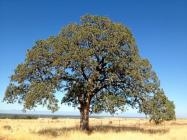By Brent McGhie, Butte County Master Gardener, August 22, 2014


These stately trees provide Californians with iconic vistas and are prized for the shade and beauty they give landowners. Oaks also furnish wildlife with food and shelter and, not incidentally, increase property values. By keeping a few cultural practice guidelines in mind, landowners can become good stewards of their oaks and preserve these trees for generations to come.
The key to living with oaks is to disturb them as little as possible. This is especially true of the root crown (the base of the trunk) and the root zone. The root zone of an oak tree covers an area one-third again larger than the outermost edge of the tree's foliage. Strive to keep this area as natural as possible.
The fungal disease “oak root rot” (Armillaria mellea) has evolved with California oaks. It is parasitic on oaks and other plant species, but if oaks are growing naturally in our moist winter/dry summer environment, this fungus is kept in check. However, if oaks are provided with summer irrigation in their root zone, Armillaria can become an aggressive, deadly pathogen. Do not water any plants under oaks during the summer: if they need watering, they do not belong there. Instead, native plants that are adapted to our Mediterranean climate can be grown under oaks. If winter rains are unusually low, a supplemental watering can be provided in the early spring. Do this by watering deeply in the outer two-thirds of the root zone.

Mature oaks do not normally require pruning, exceptfor the removal of dead, weakened, diseased, or dangerous branches. However, to incorporate oaks into a fire-resistant landscape, branches should be pruned away from the ground and kept from touching or hanging over buildings. Additionally, if the landowner wishes, an arborist can be contracted to thin 10-20 percent of the leaf area from branches three to six inches in diameter. Such thinning allows increased light into the tree canopy and decreases branch weight and wind resistance. Light pruning can be done any time of the year, but heavy pruning should be accomplished during the winter dormant season for deciduous oaks and in July or August for the evergreen interior live oak.

Under natural conditions, decomposing leaf litter provides oaks with an adequate supply of recycled nutrients, so oaks do not
normally require fertilizing. If the leaves beneath an oak have been raked up, supplemental feeding is appropriate. If they do require fertilizing, nitrogen is the element most heavily used by oaks; it should be applied at the rate of two to four pounds of actual nitrogen per thousand square feet of area. Either nitrate or organic fertilizers can be used, but organic fertilizers are preferable because their nutrients are released more slowly and they improve soil structure as well.